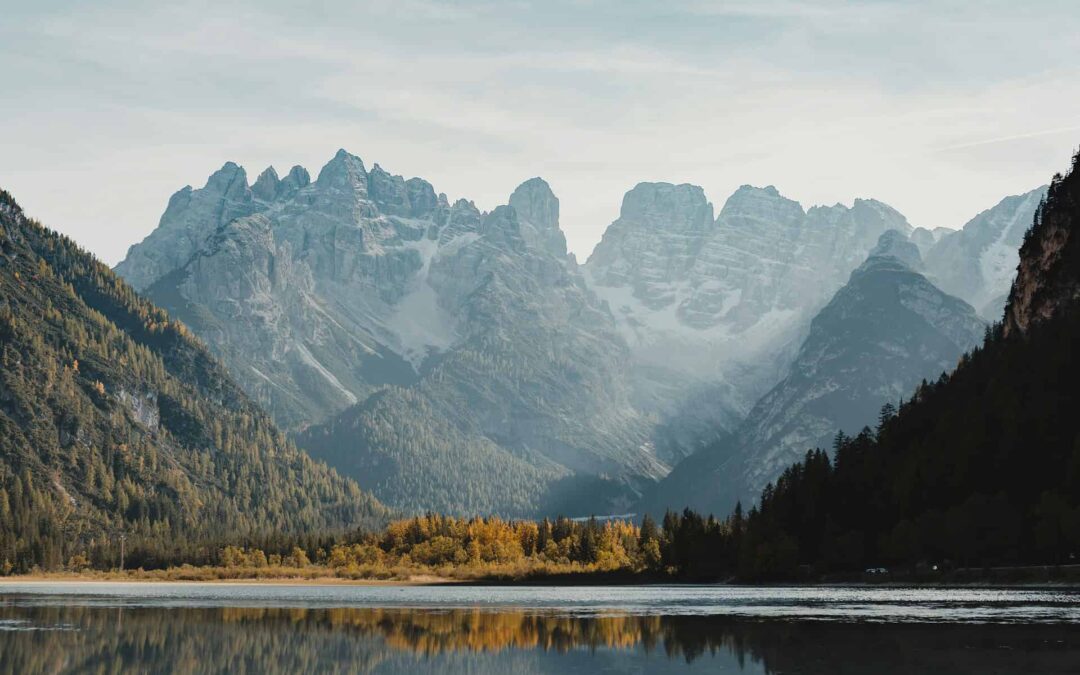The Dolomites, a world-famous ski destination, transform into an equally enchanting summer paradise, making it a top pick for those visiting northern Italy between June and September. Recognized as one of Italy’s six natural World Heritage sites, the Dolomites in summer offer a breathtaking backdrop for a wide range of outdoor adventures.
Whether you’re a sightseer seeking a laid-back getaway or a thrill-seeker in pursuit of your next exhilarating escapade, there is no shortage of incredible activities. Be sure to include these nine unforgettable experiences in your Dolomites itinerary.
Related read: Things to do in the Dolomites in Winter
Here’s an overview:
9 Things to Do in the Dolomites in Summer
Here’s a breakdown of the best summer activities in the Dolomites.
1. Trekking Through the Landscape
Follow ancient trails to roam around the heart of this mountainous wonderland and chase Instagrammable sunsets. The Dolomites are a day hiker’s paradise. The site has a vast array of trails for all experience levels. Some routes offer more views than others, but each leads to a distinct world.
Hiking the Tre Cime loop in summer lets you walk through charming flower fields before seeing Lavaredo’s prominent trio of peaks. A steep peregrination to the Croda del Becco can be taxing but fulfilling, rewarding you with a spectacular vista of Lago di Braies’ emerald waters. Cadini di Misurina’s viewpoint gives you a panorama of sharp rock monoliths piercing the alpine sky. A saunter to the famed Geisler Alm meadow is serene, taking you through forests, over creeks and past the idyllic Val di Funes.
2. Exploring the Mountains on Two Wheels
Pedal your way to the region’s stunning spots and then some. If hiking’s not your speed, riding a mountain bike is an exhilarating alternative. The Dolomites have an extensive network of cycling paths, enabling you to cover more ground, explore the surroundings in an up-tempo fashion and get your adrenaline pumping.
Biking in the Dolomites is a thrilling endeavor regardless of how you go about it. You can go solo and make it a spiritual excursion to the mountains on wheels. You can take on challenging biking trails in an intimate group and use drafting to endure longer, faster rides. You can book tours alone or with friends to enjoy more structure and revel in fun activities between rides, like experiencing the finest cheeses and wines in various quaint towns. Wines in Italy are some of the best in the world, but go easy on booze to stay hydrated and avoid being buzzed to pedal safely.
If you want to bike competitively, join a race and ride with thousands of other cycling enthusiasts. July is the best time for touring cyclists to be in the Dolomites. You can participate in Maratona dles Dolomites – Enel, where you can choose from various route lengths — 55-138 kilometers or 34-86 miles. Longer routes mean higher altitudes and fewer cars.
Alternatively, you can sign up for the South Tyrol Dolomiti Superbike, which is the most challenging cycling event in the Dolomites. You must be physically fit to endure the race’s 60-kilometer, 85-kilometer and 123-kilometer routes.
Related read: Tips for Active Holidays
3. Gazing on Rock Towers in Awe
Take in the sight of one of nature’s most remarkable sculptures. Inactivity seems counterintuitive when you travel, but hitting pause and appreciating the marvel before you can be an ecstatic experience.
Here’s a quick geology lesson — the Dolomites are a product of tens of millions of years of collision between the Eurasian and African tectonic plates. The mountain range first emerged from the tropical, shallow waters of the primordial Tethys Ocean. It started as a cluster of islands akin to the Maldivian and Bahamian archipelagos. The Dolomitic Alps have witnessed numerous extinction events and climate changes, making them relics of the planet’s turbulent past.
Ignoring the Dolomites’ geological origins and historical significance is a criminal disregard. The fact that these mighty mountains used to be coral reefs is unfathomable. Realizing these sedimentary rock and limestone formations may disappear and morph into something else someday can give you a profound sense of gratitude for their existence and your good fortune to be alive and admire them in person.
The Dolomites are a group of nine mountain systems punctuated by valleys, rivers and other mountain groups, and they look magnificent from any vantage point up close. However, Cinque Torri has a solid case for being the most fascinating. It’s a small formation characterized by five rock towers touching the sky. This 4.5-mile loop via Baita Bai de Dones is popular for backpacking, birding and hiking. Bring a snack and refuel after your trek while Cinque Torri takes your breath away.
Related read: Gear Guide: Must Haves for Camping and Hiking

4. Taking Snaps of Wildlife
Ready your camera in case an animal native to the Dolomites shows up. Summer in the Dolomites sees a wider variety of wildlife than other seasons.
The marmots have woken up from hibernation around this time of year. The temperatures are warm enough to attract migratory birds. The spotted nutcracker perches on the stone pine tree’s summit. Alpine choughs like to keep hikers company heading to the Pütia, while groups of chamois cling to steep slopes at high altitudes. Conversely, roe deer are rather bashful, so they can be challenging to spot as they forage in tall grass in their light fawn coats. Brown bears rule the forests, but mosquitoes can be deadlier than any beast.
Wildlife encounters in the Dolomites in Summer usually happen by chance, but you can frequent specific areas to spot certain species known to inhabit them. Respect wild animals and keep your distance to avoid disturbing them.
Related read: Tips on How to Take Better Travel Photos
5. Cold-Plunging Gin-Clear Water
Brave the chill and take a quick dip in a glacial lake. Many tourists prefer to rent a canoe or a kayak and stay relatively dry while adoring the crystal-clear waters in the Dolomites. However, swimming in an ice-cold lake is more invigorating. The most popular spots are Lago di Auronzo, Lago di Dobbiaco and Lago di Landro.
Cold plunging offers many health benefits, including improved blood circulation, reduced stress and enhanced immunity. It can be a therapeutic activity after a grueling hike or a taxing bike ride.
Here’s a caveat — swimming may be prohibited in some lakes, like Lago di Carezza. You may also need to make reservations, which is a new policy to help curb over-tourism. Do your homework and read updated travel guides to ensure you can dive into the lake you want to see.

6. Swarming up the Via Ferrata
Ascend the mountains through iron paths. If the weather permits, climbing the Dolomites via Ferrata routes is more than a daring endeavor to reach lofty peaks and soaring plateaus. It’s also a quasi-reenactment of the battles between Italian and Austrian troops at terrifying heights during World War I.
Steel climbing aids have replaced the original iron ones for safety reasons. Still, they’re incredibly risky. Using a Ferrata set — a pair of shock-absorbing, connected lanyards equipped with two carabiners — is a must. The weather can also be treacherous, so monitoring forecasts is necessary.
Similar to highly commercialized mountain climbing spots, such as Mount Fuji and Mount Kilimanjaro, overcrowding is a risk factor in the Dolomites. You must start your climb early in the morning to avoid long lines. Unfortunately, queueing may be inevitable. You may experience delays due to the sheer number of climbers sharing the same Ferrata route as you. Keeping your composure and maintaining a patient approach is necessary to stay safe and prevent making this dangerous activity more hazardous than it already is.
7. Sightseeing From Above
Fall in love with the Dolomites from a bird’s-eye view. Board a helicopter and tour the peaks you fancy for up to half an hour. Fly with a paraglider to see the region from a raptor’s spectacular perspective.
Ride a cable car hovering over the mountains to comfortably arrive at Tofana di Mezzo’s crest and be at the area’s third-highest peak in no time. These options suit people of all ages and varying budgets.

8. Discovering Epic Tunnels
Go inside the mountains like Italian soldiers. Another First World War remnant, Mount Lagazuoi’s tunnel system is an impressive engineering feat spanning more than half a mile along rocky edges. These artificial openings function as windows framing breathtaking views of the mountainscape.
The gallery system seems inaccessible, but it is actually painless to reach. The upper entrance is within walking distance of the Lagazuoi cable car’s top station, and the bottom entry is easily accessible from the Falzarego pass.
9. Embarking on a Scenic Road Trip
Get in a rental and traverse the Great Dolomites Road. This winding asphalt motorway presents the most convenient way to go village-hopping against the backdrop of spellbinding Dolomitic landscapes. Dedicating an entire day to this excursion is worth it, as the journey gives you a glimpse of the region’s iconic peaks and a chance to immerse yourself in alpine culture with every stop.
Travel with a group if you can. Hitting the road with company can help you feel safe and reduce your anxiety in case your car breaks down in the middle of nowhere.
Aside from indulging yourself in delicious Italian foods, you can tour centuries-old castles and learn about the region through the lens of history. The two must-sees are the Sigmundskron Castle and the Welsberg Castle. The former houses the Messner Mountain Museum Firmian, while the latter has regained its form after succumbing to a fire in the 1700s and is only open during summer.
Related read: The 9 Best Towns in the Dolomites
Conquer the Dolomites in Summer
The majestic mountains of northern Italy deserve a spot on everyone’s bucket list. The region may not be as tranquil as it looks in tourism ads due to the tens of millions of visitors it welcomes yearly, but you can capture the soul of the Dolomites if you plan your trip accordingly.



Recent Comments